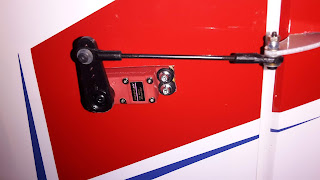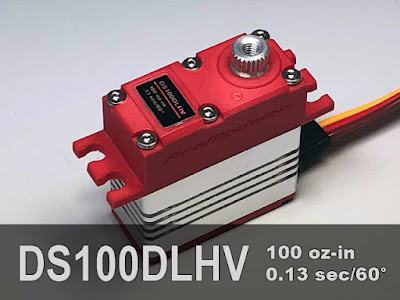Just when I was starting to think it could never get any better, glowing testimonials about ProModeler servos were hitting the net. A few of my RC Groups friends had tried them and were rabidly praising them, so I thought this had to be worth a shot, especially since my standard servos were two years old and getting a little tired.
I started with the ProModeler DS100 servos, as seen in Awesome Servo Testing__ProModeler DS100DLHV and Slick 580 EXP__The Ultimate Set Up. More than ever I was convinced this was the absolute end of development for 52" class equipment. Then John Beech told me about the DS150. While 100 inches of torque from the DS100 is enough to rip stubborn stumps out of the ground, the DS150 features half again as much at 150 full gut wrenching ounces.
When you already have enough torque (which the DS100 has), you might not think more would be useful, but it is. More power and more torque just means the servo is not as stressed as less powerful units. It's a big, powerful monster that is just loafing around taking it easy, and that's really good for reliability. Overstressed stuff doesn't do so well here.
While this is really sweet to have, the DS150 also features more speed. They are not so super rocket fast that the control surfaces blurr when you move them, but they are visually faster than the DS100, and I was happy enough with those. If you have any doubts, you can always check the specs on the page linked to below.
Unchanged are all of the DS100s quality construction, million cycle rated potentiometers, and ultra solid gear train construction and alignment, among way too many other things to mention here. For a closer look and more technical info, please check John Beech's excellent write up on the ProModeler site (scroll down a bit). Even if you are not interested in higher quality/performance servos, there is so much good information here it's well worth the read about servos in general.
If there is any downside at all, it's the extra $15 tagged onto the price tag. For extreme hardcore 3DXA pilots who hammer their equipment mercilessly, that's only $60 total on a $650 plane. When you push to that level, you need everything you can get, so that kind of money is just what you have to spend. You want the best, so you spend the money, install them and forget about it, which is exactly what you want from a servo. I don't need them to sing, and I don't need them to dance. I just demand that they perform, and even the DS100 far exceeds that. The DS150 is just more of all that.
This price is still extremely competitive (and sometimes less) than other company's premier servo, so most of them will spend it happily. For regular 3D sport pilots, the DS100 at $39.99 is still going to be way more servo than they can get for a comparable price.
Astute readers will remember I'm not necessarily a tech guy (and don't pretend to be), and this isn't a tech blog. I'm a flying guy and this is a flying blog. Specs are great if you love numbers and want to nitpick speeds down to the hundredth of a second, or torque down to the last quarter ounce, but I believe the real story is always in the flying. Specs will give you an idea of how well the servo will work, but I don't believe anything until I fly it.
Now, if you are a spec guy, you can check the specs and make up your own minds, but I'm going to stick to telling you what things do in the air.
FLYING
Extreme Flight Extra__No Title.mp4 from Doc Austin on Vimeo.
The most important improvement I've noticed moving to ProModeler servos is how their superior centering changed the flying dynamics, and even my own style as I adapted to that. Being able to trust the plane to go where you point it and stay where you put it every time, all the time, is such an invaluable thing you can't appreciate it until you have actually flown the plane. With both the DS100 and DS150, you trim it once and forget about it. The plane stays in trim for flight after flight, and you can trust it to stay trimmed.
This is extremely important when trying to fly precisely, and especially on the deck. You have to know when you center the sticks the plane isn't going to climb or (worse) dive, yaw or roll on you, and the lower you fly the more important this is. In this respect, it's all about trust, and when you can trust the plane, you can fly it better and more confidently.
In this respect, these servos are virtually inseparable, simply because the DS100 already centers at a level that will transform any plane you put it in. There may be some credibility in the theory that higher torque will give you tighter centering, but once you get to perfect it's overkill.
John Beech explained to me that the DS150 would work better for flying 3DXA with a gyro because the faster servo reacts to the gyro much more quickly. After flying the servos I have a better understanding of what he meant. How this plays out is the plane is so much better locked in and you will feel much more "connected." It's much the same reaction I had after flying DS100s for the first time, though not quite as shocking. I was not prepared to believe anything could be better than the DS100, and while the differences are subtle, they are there.
I've been flying this red Extra so much,. and I am now so used to the feel of the DS100 that I fell into the groove right away. I had to work up to find the limit because I was trying something new, but after a flight or two I could tell the DS150 equipped plane was just better all the way around. I have flown my DS100 equipped blue Extra back-to-back with my DS150 equipped red to give me an instant contrast between the two. The difference was not blinding, but it was there and the DS150 is definitely better.
So, what does all of this mean to you? I think the average sport 3D pilots will be delighted with the DS100 and never need anything more. Most of them will never even dream there is anything better, like of like I was after flying the DS100 the first time.
The DS150 is more for the demanding pilots who fly on the ragged edge all the time. I've been flying RC for over 40 years and it was hard for me to pinpoint the differences. It's a subtle improvement, and this is what you get when you move up in quality. You pay more for smaller improvements, but if you want everything you can get, it's worth it.
. The DS150 is for the guy who is scratching and clawing to get every last possible bit of performance he can, and for those guys there's really no reason to look at anything other than the DS150.
SET UP
I used a mixed bag of servo arms on this plane to get the desired set up. First is Xessories excellent 1.25" 25 tooth spline arm. I've used these on all of my 48, 52 and 60" plane's elevators since their introduction. I would use this arm on everything if it were available in the 7/8" I prefer for my ailerons. The other is the less blingy, but completely functional ProModeler PDRS101 1" arm t5hat features the second from the outside hole at 7/8", so that's perfect for me.
Ailerons
Using ProModeler's excellent 1" arm, I get a perfect 33 degrees of aileron. Some guys like more, but I can fly this much more smoothly than a longer arm.
Elevator
Here I like the 1.25" Xessories arm. I'm getting about 84 degrees of travel with this. If you are comfortable with less, use the next hole in. I had to use a flat file and open the servo hole downwards a litte to get the ball link to clear the bottom of the stab, but that was minor and only took a couple of minutes.
Worth noting is when I tried the DS100 in my blue Extra, all I had was a 1" arm, but that was still enough elevator I could fly my whole program. The extra throw is used more as an airbrake anyway, so if that doesn't suit your style, the next5 hole in is still plenty of travel.
Rudder
Here I used the second hole in the 1" arm, which was not quite enough. I used the travel adjustments in the Aura to turn it up about 10% on each side and the rudder almost hits the elevator at full deflection, which is just perfect.
Notice the I put the ball link on the inside of the servo arm. This gives it a straighter shot to the control horn at full deflection, which make it more efficient.














